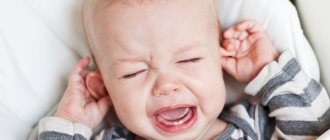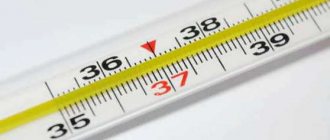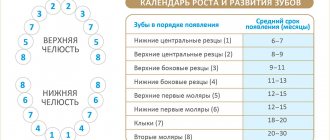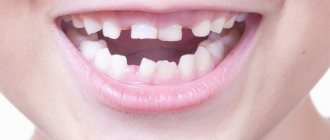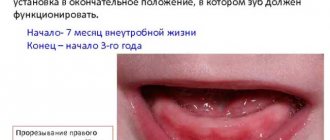The appearance of an infant’s first milk teeth is a difficult period for both him and his parents. The baby often cries, is capricious and demands increased attention from mom and dad. Teething is often accompanied by an increase in temperature. It lasts for 1-3 days, after which the child’s condition stabilizes.
Teething can be called a purely individual process. In some children it is completely asymptomatic, while in others very unpleasant symptoms appear that significantly worsen the baby’s life - diarrhea, hyperthermia, loss of appetite, inflammation of the gums and others. This clinical picture often confuses parents - they cannot understand whether these signs are related to teething or whether the child is developing some kind of pathology.
Parents' biggest concern during teething is temperature. It can rise to dangerous levels - 39-40°C. To alleviate the child’s condition, it is necessary to be able to provide him with first aid, as well as to recognize in time the signs indicating that you urgently need to either call an ambulance or go to the hospital yourself.
Why does the temperature rise
Teething is a traumatic process. Dental units damage the gum mucosa and inflammation occurs, which in medicine is called aseptic (microbial-free). This process is accompanied by an increase in temperature. In addition, during teething, some processes occur in the baby’s body that stimulate hyperthermia:
- at the site of localization of future milk teeth, specific substances necessary for softening the bone tissue of the jaw begin to be actively produced;
- Since all the forces of the child’s body are aimed at teething as quickly as possible, the immune system weakens a little. During this period, infectious agents present in the body may become active and diseases will begin to progress. Many of them are accompanied by an increase in temperature.
Damaged gums are the “entry gate” for infection. Through them, pathogenic microflora can penetrate the body and provoke the development of a septic inflammatory process. The body also responds to such an attack with an increase in temperature. To prevent infection, it is recommended to take more careful care of your baby’s gums during this difficult period for him. Pharmaceutical companies now produce many drugs that have a triple effect - relieve pain, reduce inflammation, fight viruses, bacteria and fungi. But before using these medications, it is recommended to consult your pediatrician.
Physiological diarrhea in a child
Diarrhea in a child may occur due to changes in climatic conditions.
Doctors have a definition of “physiological diarrhea,” which is quite common in young children for various reasons, such as:
- teething;
- changes in climatic conditions;
- the body's response to the introduction of a new food product.
With “physiological diarrhea,” the child behaves as usual: sleeps peacefully, is active, and does not cry for no apparent reason.
This situation is the norm; usually diarrhea goes away quickly without medical help; you can, perhaps, make adjustments to the diet of the mother and child (if he is already eating complementary foods).
But if symptoms such as vomiting and fever appear, then immediately consult a doctor to prevent complications.
Teething symptoms
A child's first teeth begin to erupt between 4 and 8 months. There are exceptions. Sometimes children are born with several teeth, while others show them only after a year. Teething is a difficult process for a child. It can be accompanied by various symptoms, but the most common are the following:
- How long does it take for drugs to leave the body?
- Increased nervousness. The child cries for no reason, whines. Teething may be accompanied by painful sensations that prevent him from sleeping normally. As a result, the regime of wakefulness and rest is disrupted.
- Heavy salivation. This is a protective process. Saliva has anti-inflammatory and bactericidal properties. Hypersalivation helps protect inflamed gums from infection. Sometimes there is so much saliva that it flows down the chin onto the neck and chest. You should not constantly rub your baby's delicate skin. It is permissible to periodically carefully blot with dry wipes.
- Loose stools. During teething, the baby may experience diarrhea. It is caused by increased salivation, changes in intestinal microflora, or increased bacterial activity due to a decrease in the body's immune defense.
- Decreased appetite. Often, due to pain in the gums, infants refuse to eat. In this case, it is a little easier for those who are breastfed, since the sucking process calms and pacifies the baby.
- Inflammation of the gums. This is the natural state of affairs at the time of teething. If a white stripe appears in some place of the gum, the tooth will soon come out.
- Runny nose. Sometimes swelling and inflammation from the gums spreads to the nasal mucosa. As a result, the baby begins to snot.
- Itching in the gums. The baby puts all the objects that come to hand into his mouth. This is how he scratches his gums. To make his task easier, you can purchase special teething toys in stores.
- Hyperthermia. The temperature rises in 80% of cases. It is important to ensure that it does not reach critical levels. Once every 1-2 hours, it is recommended to measure it not with an electronic, but with a mercury thermometer, since it is more reliable.
All these symptoms frighten parents, as they are similar to the signs of many other diseases of the upper respiratory tract and gastrointestinal tract. These symptoms are typical for teething. But you need to monitor the baby’s condition very carefully, and if the clinic is accompanied by other alarming symptoms, you need to immediately contact your doctor.
First teeth
When to expect
The baby's milk teeth are formed at the 7th–8th week of intrauterine development, and the permanent ones at the end of the 4th month of pregnancy. In total, a child develops 20 baby teeth, while 32 permanent teeth. To provide the baby with a Hollywood smile, the expectant mother needs to eat properly throughout the nine months of pregnancy. There are no calcium preparations that are 100% absorbable, so it is very important to get “natural” calcium from food, especially cottage cheese. And, of course, the pregnant woman herself needs to have all her teeth treated - now there are very gentle technologies for this.
The eruption of the first milk teeth in most cases begins at 3–8 months of the baby’s life and ends closer to three years. But it also happens that children are born with one or two teeth, or teeth may erupt in the first weeks of life. Often the timing of teething depends on genetic characteristics, but much more strongly on other factors. Diseases of the baby also affect the teeth (for example, with rickets, frequent ARVI and dyspepsia, teeth erupt later). It’s worth paying attention to the nature of your diet, the quality of drinking water, even the climate! On average, northern residents start teething a little later than southerners. Sometimes teething is delayed, and the first tooth appears closer to a year. Usually there is nothing wrong with this. It is believed that it is not so much the timing that speaks about a child’s health, but rather the order in which teeth erupt. If it is broken, pay attention to this fact and show the baby to the pediatric dentist.
The process has started
The fact that the teething process has begun is indicated by profuse salivation. In addition, the baby begins to put into his mouth everything that comes to hand. This means that the gums are itchy, causing him discomfort. Trying to relieve the itching, the baby instinctively acts correctly - micromassage of the gums improves microcirculation in them, teeth erupt easier and faster. During this period, provide your child with teethers: hypoallergenic silicone toys filled with water. The teether should not be cooled in the freezer - only in the refrigerator: otherwise the baby will get hurt on a hard surface. If the gums are very swollen and the baby is crying in pain, use special dental gels that have a mild local anesthetic effect.
For most children, the teething process goes quite smoothly. There may be short periods of anxiety, disturbances in daily routine and nutrition. Sometimes even teething is accompanied by diarrhea, runny nose, cough and fever. And during the period when teeth appear, the baby is vulnerable to all kinds of infections. The baby’s immunity is weakening these days, and it is easier for him to “catch” the virus, so you should not attribute the deterioration of the condition only to the teeth. If a child has a fever when a tooth is being cut, you need to look for another inflammatory source in the body.
At 6 months
The baby usually boasts central lower incisors. This is a reason to start brushing your teeth. Why so early? Baby teeth are small and sharp, have an uneven wavy edge, stand close to each other and, as a rule, have a yellowish tint. These teeth have a low degree of mineralization. Their enamel and dentin are very thin. All this contributes to the rapid occurrence and spread of caries. In order to prevent it, you need to regularly brush your teeth: for this you can use various massage brushes, which not only accustom the child to hygiene, but also facilitate the teething process itself. We immediately teach you how to brush your teeth correctly - from the gums to the edges, with slightly “sweeping”, semicircular movements, and in no case horizontally. If possible, brush your teeth after every meal (and at least twice a day). Isn't there such a possibility? Give the baby something to drink - the water will wash away any remaining food.
At 8 months
The upper central incisors usually erupt.
At 9 months,
the upper lateral incisors appear.
At 11 months,
many children's lower lateral incisors are already in place!
By the age of one year, a baby normally already has eight teeth
.
But there may not be any - delayed teething occurs in 25% of cases with normal psychomotor development of the child. In extremely rare cases, the absence of teeth is associated with adentia - the absence of their rudiments. This can be checked by a pediatric dentist using radiovisiography. By 13–15 months,
the upper first molars appear first, followed by the lower ones.
From the age of one year, your baby can brush his teeth with children's toothpaste and a special children's brush. The service life of the brush is no more than 2 months, even if it looks like new. Many kids swallow the tasty pasta. There is no need to be afraid of this if it is for children and its quantity is no more than a pea. Of course, until 2–2.5 years of age, teeth brushing should be done with the help and then under the watchful supervision of the mother.
At 18 months
fangs erupt.
Typically, these teeth cause more problems than others; their eruption is more painful, and this process is often accompanied by discomfort. At 20 months,
the second molars erupt.
And sometimes already at this age the mother can notice the first problems. Doctors reassure: carious baby teeth are not a reason to worry that permanent teeth will also be bad. As practice shows, there is no pattern here. Of course, if parents do not neglect disease prevention and dental hygiene. At 2.5 years old, a child normally has a full set of baby teeth.
There are 20 of them - 10 on each jaw .
Baby teeth don’t last very long – soon they will begin to fall out and permanent ones will appear in their place. Usually the change of teeth begins at about 5–6 years and lasts until the age of 20, when wisdom teeth erupt.
Starting from 6 months, you must come for a preventive examination twice a year. When this becomes a habit, the baby will not be afraid of doctors, and by the age of 7–8 years (when a visit to the clinic can no longer be avoided) he will sit completely calmly in the dental chair
In order for your baby’s teeth to grow strong and healthy, you need to start taking care of them almost before conception. It’s also better to meet the dentist early
Timing of eruption and loss of baby teeth
| Upper teeth | |||
| Tooth name | Period of eruption | Teething order | Drop date |
| Central incisor | 8 months – 1 year | 2 | 6–7 years |
| Lateral incisor | 9 months – 1 year 2 months | 3 | 7–8 years |
| Fang | 1 year 3 months – 1 year 10 months | 7 | 10–12 years |
| First molar | 1 year – 1 year 6 months | 5 | 9–11 years |
| Second molar | 2 years – 2 years 8 months | 10 | 10–12 years |
| Lower teeth | |||
| Central incisor | 6 months –10 months | 1 | 6–7 years |
| Lateral incisor | 10 months –1 year 4 months | 4 | 7–8 years |
| Fang | 1 year 4 months – 2 years | 8 | 9–12 years |
| First molar | 1 year 2 months – 1 year 7 months | 6 | 9–11 years |
| Second molar | 1 year 10 months – 2 years 8 months | 9 | 10–12 years |
Symptoms indicating pathology
An increase in temperature during teething is a natural process. This is a kind of protective reaction of the baby’s body. At this time, it is necessary to carefully assess the general condition of the child. Sometimes dangerous pathologies can be hidden behind teething syndrome. Therefore, parents should know the symptoms indicating the progression of the pathological process:
- Vomit. Single vomiting can occur at high temperatures. But if it recurs, the baby feels very bad and has diarrhea, you need to see a doctor as soon as possible. These are signs of intestinal infection or poisoning.
- Nasal congestion or discharge of thick yellow-green snot. This is not the norm, it is a pathology that requires adequate and immediate treatment.
- Coughing. During teething, a lot of saliva is released. Often children simply do not have time to swallow it, and they may choke. A cough appears reflexively, which is not pathological. But if wheezing is heard and a certain amount of sputum is released during coughing, this indicates the development of diseases of the upper respiratory tract (tracheitis, bronchitis and others).
- Stomach ache. With normal teething, this symptom should be absent. If the baby is restless, capricious, cries, or pulls his legs toward his stomach, these are alarming signs. Especially if the abdominal pain is accompanied by repeated vomiting. This symptom complex indicates the development of an intestinal infection. The child could pick it up through toys and other objects that he pulled into his mouth.
- Red throat. Swelling from the gums does not spread to the palate. It can spread to the nasal cavity. If the throat and palate are hyperemic (reddened) upon examination, this is the first sign of the development of pharyngitis.
If you have at least one of these symptoms, you should immediately contact your doctor or go to a medical facility. There the child will be examined by a pediatrician and prescribed the correct treatment. It is prohibited to give any medications (except antipyretics) at home without prior approval from the doctor.
Causes of diarrhea in an infant
Teeth coming through can cause diarrhea.
There are cases when you can independently rid a child of an illness such as diarrhea, but some situations require medical intervention. Below are the main causes of diarrhea in infants:
- Nutrition for a nursing mother. It happens that after using some new product, a mother notices changes in her child’s stool. Diarrhea can be caused by eating fresh fruit, vegetables, herbs, or too fatty foods. Treatment is limited to correcting the feeding mother’s diet and eliminating the “provocateur product” from the diet.
- Baby food. Cases when a child experiences diarrhea due to dietary habits: an allergic reaction to an adapted formula; start of complementary feeding (4-6 months); consumption of a previously unfamiliar product; untimely introduction of the product (the child’s digestive system is formed gradually, so it is advisable to introduce the products, following the advice of the WHO); insufficient amount of enzymes. This problem can also be solved by adjusting the diet.
- Lactase and gluten deficiency. This problem is a child’s intolerance to cereals and dairy products. Recently, such cases have become more frequent; children do not have enough enzymes necessary to digest this kind of food. If the problem of lactase deficiency arises during breastfeeding, then the mother needs to exclude dairy products from the diet, and if with artificial milk, transfer the baby to low-lactose adapted formulas. If you have gluten deficiency, you need to exclude cereals such as wheat, semolina, barley, as well as bread, buns, cookies and other baked goods from your baby’s diet. Signals for testing for lactase and gluten deficiency (in addition to constant diarrhea) are skin rashes and insufficient weight gain in the baby. The problem of milk intolerance may disappear on its own after the baby is four months old, as his body will be prepared to produce the necessary enzymes required to digest mother's milk.
- Teething. When a baby gets a new tooth, he may experience diarrhea. There is no need to treat it; after the tooth hatches, the problem will disappear. Reasons: excessive secretion of saliva and its entry into the gastrointestinal tract, impaired peristalsis, weak immunity, infection in the intestines, irritated intestinal walls.
- Intestinal infection. This is the most common cause of diarrhea in infants. It is not at all difficult to get an intestinal infection, since the baby puts everything that comes to hand into his mouth, so it is important to monitor the cleanliness of foods and objects that are accessible to his eyes. In a mild form, such an infection is not dangerous and goes away on its own in a short period of time. If everything is much more serious, then you can observe an elevated temperature and severe diarrhea. An intestinal infection can cause acute diseases such as dysentery, amoebiasis, salmonellosis, etc. These diseases lead to fever, vomiting, critical dehydration, and weight loss. If you have such signs, you should immediately consult a doctor. In particularly difficult situations, you will have to go to an infectious diseases hospital.
- Dysbacteriosis. The very concept of dysbiosis does not imply a specific disease; it is a kind of violation of the proportions of beneficial microflora to pathogenic ones. Dysbacteriosis in infants is very common, which is explained by the incompletely formed organs of the digestive system. There is debate about whether it is worth taking measures for a child who is 2-3 months old? Some doctors prescribe taking probiotics, which should restore the balance of the intestinal microflora, while others are convinced that the baby’s gastrointestinal tract is immature for natural reasons, so interfering with the microflora of a child under 12 months is more likely to harm than benefit.
- Congenital intestinal pathologies. This phenomenon is very rare, but it still occurs. Acute surgical pathologies: appendicitis, peritonitis (inflammation of the abdominal cavity), intussusception (gastrointestinal obstruction). Symptoms of acute pathologies: sharp pain in the abdominal area, elevated body temperature, vomiting, bloating. You should not put off visiting an ambulance if your baby has similar symptoms.
How long does the temperature last
During teething, the temperature rises on average to 37.7°C. This has practically no effect on the general condition of the child. He is active, eats well, plays. But hyperthermia can also reach high numbers - 39-40°C. In this case, the baby is lethargic, capricious, and refuses to eat. It is better to take measurements every 1-2 hours. If the increase is critical, an antipyretic drug should be given. Normally, the temperature during teething can last up to three days. If hyperthermia is present even on the 4th day, you cannot do without the help of a doctor.
When to lower the temperature
There is no need to lower the temperature to 38.5°C. If it rises higher, you need to take action. Hyperthermia affects many processes in the human body. During fever, the water-salt balance is disrupted and the load on the heart increases. In severe cases, convulsions may occur that can lead to respiratory arrest. In no case should this be allowed to happen, as this would pose a threat not only to the health, but also to the life of the little patient.
- How many days does a baby's teething temperature last?
When to give antipyretic drugs:
- temperature exceeded 39°C;
- breathing rate increases;
- the baby sleeps for a very long time;
- the child is restless, cries, cannot calm down;
- drying of mucous membranes, redness of the skin;
- the occurrence of convulsions (in this case, they give an antipyretic and immediately call an ambulance).
If the child has already had convulsions once, the temperature must be brought down when it exceeds 38°C.
When teeth start cutting
There is no exact answer as to what time a child’s teeth are cut – the timing varies from person to person. However, you can focus on the average, standard periods of eruption approved by WHO:
- the lower incisors appear at 6–7 months;
- upper – at 7–8 months;
- upper lateral incisors – at 8–9 months;
- the lower ones are closer to a year.
According to the standard, a one-year-old child must have eight baby teeth.
From one year to one and a half years, the child acquires larger teeth - upper and lower molars, and from fifteen to twenty months - upper canines, which are also called “ocular.” The fact is that the optic nerve runs next to them, so these teeth are often more difficult for the child than others. Irritation of the nerve causes sharp pain and sometimes watery eyes.
It can be difficult even for a doctor to understand that the first teeth are being cut. After all, this process is often accompanied by an increase in temperature, changes in stool and mood, and refusal to eat.
What can you do to bring down the temperature?
An increase in a child's temperature is always a reason for panic among his parents. But it is important to control yourself and be able to properly help your child. To normalize body temperature, you can resort to methods of traditional and folk medicine.
Medications
For young children, it is best to give the medicine in syrup form or use rectal suppositories. Both the baby and the older child will refuse to take the bitter pill, and giving it to him will be problematic. If you don’t have anything else at hand, then you can try mixing the medicine with something tasty - honey, fruit puree.
Medicines for fever in a child
To normalize a child's body temperature, medications based on paracetamol or ibuprofen are used in pediatrics. The first can be given to a baby from the first days of life, the second - from three months. Before use, you should consult with your doctor, and also study the instructions for the drug in detail, paying special attention to side effects and dosage.
Traditional methods
If you don’t have the required medications in your medicine cabinet at the right time, you can resort to traditional methods of lowering your temperature. They allow you to reduce the heat by 1-2 degrees. This is often enough to stabilize the child’s general condition.
Effective methods:
- Toothache and fever
- Physical cooling with a diaper or sheet. This method can hardly be called purely folk, since it is also used in medical institutions. Its essence is to cool the “burning” human body. It is necessary to wet the diaper in warm water and wrap it around the baby.
- Rubbing with warm water. It is necessary to prepare a sponge and a deep container with water. Her temperature should be 36-37 degrees. Water that is too cold can cause chills and even trigger cramps. Hot water will not bring the expected effect. Take a little warm water into a container, moisten a sponge in it and carefully wipe the child’s feet and hands, elbows and knees, and armpits.
- Cabbage leaves. They need to be kept in boiling water, and then beaten a little, cooled and applied to the baby’s body.
- Linden blossom. It can be given even to children under one year old. It has a pronounced diaphoretic effect. As a result, the child sweats and body temperature decreases. Use after consultation with a specialist and in the absence of an allergic reaction to this plant.
It is best to use traditional methods of treatment in tandem with traditional ones. This will not only achieve the desired effect, but also quickly improve the child’s condition.
What not to do when teething
It’s hard to look at a child when you know that he’s feeling bad right now. Therefore, many parents try to take some measures to somehow help their child. But not everything goes to his advantage. During the teething period, you cannot rush the course of events. Teeth will erupt in any case. If you try to speed up this process, you can only do harm.
What not to do:
- give adult medications to bring down the temperature;
- wipe the child with vinegar or alcohol;
- massage the gums;
- make cuts on the gum so that the tooth emerges faster;
- give the child dry bread crust (it can scratch the swollen tissues in the mouth and infection can penetrate through the wounds).
Now in children's stores there are a sufficient number of various “rodent” toys, as well as pain-relieving gels that will help simplify the teething process and reduce pain and inflammation. It is to them that you need to resort if there is a need to help the baby.
“Rodents” for teething children
Baby teeth in children: order of eruption
Any newborn baby has follicles of milk teeth (20 pieces) and molars (16 pieces) inside the jaws. The remaining 16 rudiments will form later.
Teething in infants begins with the lower jaw: first the central incisors appear (6-10 months of the child’s life), then the canines (10-13 months), then comes the turn of the first (14-18 months) and second (17-23 months) molars .
Emerging teeth differ from adult teeth in having low-mineralized enamel. If you do not maintain oral hygiene, caries may begin to develop. In addition to careful adherence to hygiene rules, special gels and ointments that significantly accelerate the mineralization process will help make teeth stronger and more resistant to pathogenic microorganisms.
